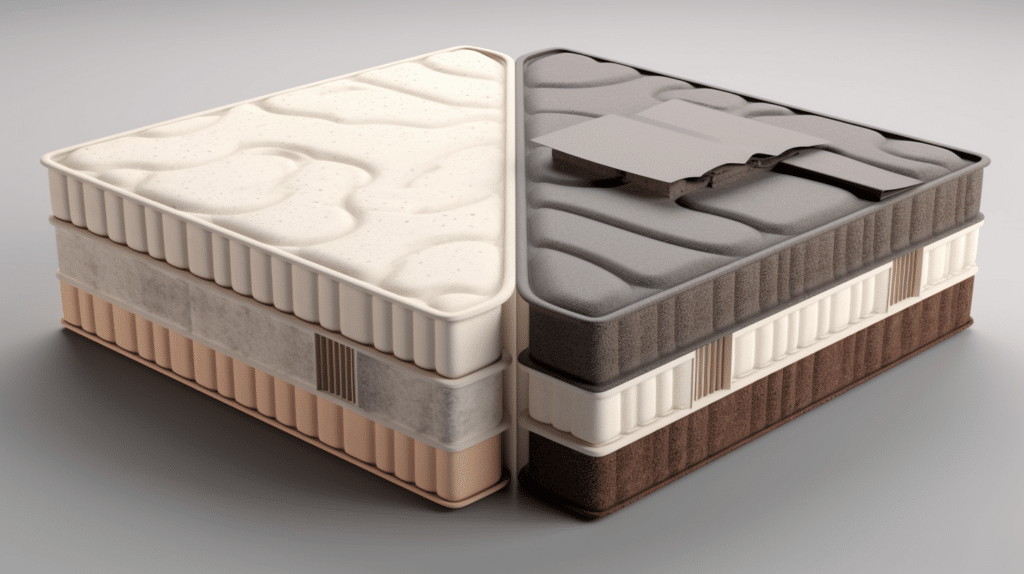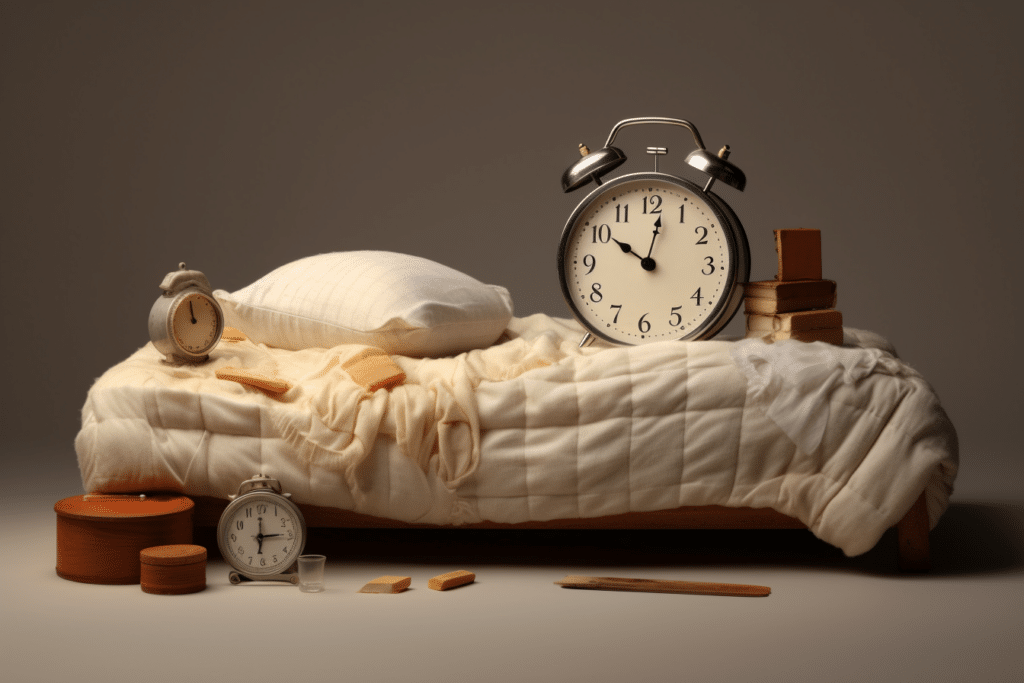Last Updated on August 4, 2023
The debate surrounding the ideal mattress type for optimal sleep quality has been persistent as consumers are presented with a multitude of options. Among these various options, memory foam and pocket-sprung mattresses have emerged as popular contenders in the quest for superior comfort and support during slumber. Memory foam mattresses, composed of viscoelastic polyurethane material, conform to an individual’s body shape and distribute weight evenly across the surface. On the other hand, pocket-sprung mattresses consist of individually enclosed springs that work independently to provide tailored support to different areas of the body. The following article delves into a comprehensive comparison between these two mattress types by examining factors such as support, comfort, durability, lifespan, and suitability for various sleepers.
In order to make an informed decision when choosing a mattress type that best suits an individual’s needs and preferences, it is essential to consider empirical evidence derived from scientific research studies. This evidence-based approach not only ensures accuracy but also minimizes potential biases or misconceptions about each product’s capabilities. By analyzing such data in conjunction with personal requirements and budget constraints, one can make a well-informed choice between memory foam and pocket-sprung mattresses. This article aims to equip readers with pertinent information pertaining to both mattress types while maintaining an objective standpoint devoid of personal opinions or anecdotal accounts.
Key Takeaways
- Memory foam mattresses offer personalized support and pressure relief, making them an excellent choice for side sleepers.
- Pocket sprung mattresses provide exceptional support and comfort, suitable for back or stomach sleepers who need spinal alignment without excessive sinking.
- Each mattress type presents unique advantages in terms of comfort or support characteristics, and personal preference plays a significant role in the overall comfort provided.
- Factors such as sleep positions, body weight, and allergies can influence the decision between memory foam and pocket-sprung mattresses.
Memory Foam Mattresses
Innovative and adaptive, memory foam mattresses have garnered significant popularity due to their unique ability to conform to an individual’s body shape, providing personalized support and pressure relief. This contouring effect is achieved through the utilization of viscoelastic polyurethane foam that softens in response to heat, allowing it to mold around the user’s body. As a result, memory foam mattresses distribute weight evenly across the surface, reducing pressure points and promoting optimal spinal alignment.
Temperature regulation within memory foam mattresses can be both advantageous and disadvantageous for users. Due to its heat-sensitive nature, memory foam has the potential to retain warmth which may lead to discomfort for some individuals who sleep hot or reside in warmer climates. To mitigate this issue, manufacturers have developed various cooling technologies such as gel-infused foams or open-cell structures that enhance breathability and temperature control. In terms of allergy considerations, these mattresses are hypoallergenic as they possess a dense structure that discourages dust mites from inhabiting them.
Memory foam mattresses offer numerous benefits, including tailored support and effective motion isolation; however, they are not without their drawbacks. Their temperature sensitivity may cause issues for those seeking a cooler sleeping environment, while their slower response time might make it difficult for some individuals to change positions easily during sleep. Despite these concerns, many find the contouring properties of memory foam highly beneficial in alleviating pain associated with joint pressure or chronic conditions like arthritis or fibromyalgia.
Pocket Sprung Mattresses
Exceptional support and comfort are provided by pocket-sprung mattresses, which consist of individually encased springs that work independently to contour the body’s shape and respond to pressure points. These mattresses offer a more traditional feel compared to memory foam while still delivering advanced technology for enhanced sleep quality. Various pocket spring types exist in the market, including Miracoil, continuous coil, and offset coil systems, each with unique characteristics to cater to diverse preferences and requirements.
Motion isolation is another key advantage of pocket-sprung mattresses, as each individual spring absorbs movements without transferring them across the mattress surface. This feature is particularly beneficial for couples or those who share their bed with a restless sleeper. Furthermore, pocket sprung mattresses provide optimal spinal alignment due to their ability to distribute weight evenly across the sleeping surface. The combination of motion isolation and effective pressure relief make this type of mattress an appealing option for individuals seeking improved sleep quality.
The breathability of pocket-sprung mattresses also sets them apart from other types such as memory foam. The design allows air circulation within the mattress layers, preventing heat retention and ensuring a comfortable sleeping temperature throughout the night. Moreover, these mattresses tend to be more durable than their foam counterparts due to the robustness of metal springs which can withstand long-term use without significant loss in support or comfort levels. Overall, pocket-sprung mattresses offer an excellent balance between comfort, support and longevity that appeals to a wide range of sleepers.
Comparing Support and Comfort
Undeniably, the quest for optimal support and comfort in a mattress plays a pivotal role in determining sleep quality, with various factors such as materials, construction, and individual preferences influencing the ultimate choice. Memory foam and pocket sprung mattresses are two popular options that offer distinct advantages in terms of support and comfort. Pressure relief is an essential aspect to consider when comparing these mattresses types, as it significantly affects how well the mattress conforms to one’s body shape and distributes weight evenly across the surface.
Memory foam mattresses are known for their superior pressure relief properties due to their viscoelastic nature. This material responds to body heat and weight by molding itself around the sleeper’s contours, which provides personalized support and helps alleviate pressure points. Additionally, memory foam offers excellent motion isolation capabilities, thus, reducing disturbances caused by movement from a sleeping partner. On the other hand, pocket-sprung mattresses consist of individually wrapped coils that work independently to provide tailored support based on body weight distribution. These springs allow for effective pressure relief but may not be as contouring as memory foam.
When evaluating the overall comfort provided by each mattress type, personal preference plays a significant role. Some individuals prefer the enveloping feel offered by memory foam, while others appreciate the responsive support provided by pocket-sprung mattresses. Factors such as sleeping position preferences and whether an individual experiences pain or discomfort during sleep should also be taken into account when making this decision. It is crucial for potential buyers to assess their unique needs carefully before selecting between memory foam or pocket-sprung options in order to achieve restful nights characterized by proper support and optimum comfort levels.
Durability and Lifespan
Evaluating the durability and lifespan of different mattress types is a crucial consideration for consumers, as it directly impacts long-term satisfaction and investment value. Memory foam and pocket-sprung mattresses exhibit distinct characteristics that contribute to their respective durability factors and lifespan variations. A comprehensive understanding of these aspects can assist individuals in making informed decisions when selecting a suitable mattress option.
- Material composition: Memory foam mattresses are constructed from layers of high-density polyurethane foam, which conform to the body’s shape to provide pressure relief and support. Over time, the material may show signs of sagging or lose its ability to regain its original shape upon pressure release. On the other hand, pocket-sprung mattresses consist of individually wrapped coils encased within fabric pockets, providing consistent support across the surface. These individual springs allow for better weight distribution and minimize sagging issues in comparison with memory foam.
- Maintenance requirements: To maintain optimal performance, both memory foam and pocket-sprung mattresses require periodic rotation or flipping. However, memory foam mattresses may be more prone to developing permanent indentations due to their viscoelastic properties; therefore, they may necessitate more frequent rotations than pocket-sprung options.
- Manufacturer warranties: Generally speaking, warranty periods serve as indicators of product quality and longevity expectations set by manufacturers. While most memory foam mattress manufacturers offer warranties ranging from 10-25 years, pocket-sprung mattress warranties typically fall between 5-15 years.
Notably, environmental factors such as temperature fluctuations or humidity levels can also impact the overall durability of both memory foam and pocket-sprung mattresses over time. Additionally, personal usage patterns – including sleep position preferences or individual body weight – will inevitably influence how each type performs throughout its lifespan on an individual basis. Ultimately, while each mattress type presents unique advantages in terms of comfort or support characteristics previously discussed in prior sections, it remains essential for consumers to weigh these benefits against potential drawbacks related to durability concerns when assessing their long-term investment value.
Suitability for Different Sleepers
A thorough analysis of the suitability for different sleepers is imperative when choosing between mattress types, as individual needs and preferences play a significant role in determining overall satisfaction and comfort. Factors such as sleep position, body weight, and allergies impact can influence the decision between memory foam and pocket-sprung mattresses. Each type offers distinct features that may benefit specific sleepers more than others.
For instance, memory foam mattresses are known to provide superior pressure relief and contouring support, making them an excellent choice for side sleepers who require cushioning at the shoulders and hips. Additionally, these mattresses tend to isolate motion better than pocket-sprung options, which may be advantageous for couples with differing schedules or those easily disturbed by their partner’s movements during the night. On the other hand, pocket-sprung mattresses offer firmer support suitable for back or stomach sleepers who need spinal alignment without excessive sinking into the mattress surface. These models also allow greater airflow due to their coil construction, resulting in a cooler sleeping experience compared to traditional memory foam.
Taking into account factors such as sleep positions and allergies impact is essential in selecting the most appropriate mattress type. Memory foam tends to be hypoallergenic due to its dense structure that inhibits dust mites’ growth; this feature could be particularly beneficial for individuals with allergies or respiratory issues. Pocket sprung mattresses may not offer the same level of hypoallergenic protection but excel in providing targeted support through individual coils working independently from one another. This attribute ensures even distribution of body weight across the mattress surface, leading to reduced pressure on joints while maintaining proper spinal alignment—an essential aspect for achieving restorative slumber irrespective of sleeping position preference or physical condition.
Making the Right Choice
Selecting the ideal mattress type requires careful consideration of individual needs and preferences, as each option presents unique advantages that cater to specific sleep requirements and comfort levels. Memory foam mattresses are known for providing pressure relief and body contouring, making them suitable for individuals with joint pain or those who prefer a softer sleeping surface. Pocket-sprung mattresses, on the other hand, offer targeted support and greater breathability, which may be more appropriate for individuals who require additional spinal alignment or prefer a cooler sleeping environment.
Sleeping positions play a critical role in determining the most suitable mattress type. Side sleepers often benefit from memory foam mattresses due to their ability to conform to the body’s shape, thereby reducing pressure points on shoulders and hips. Back sleepers may find pocket-sprung mattresses more suitable as they provide adequate support while maintaining proper spinal alignment. Stomach sleepers can benefit from both types depending on personal preferences for firmness levels; however, it is essential to ensure that sufficient support is provided to avoid potential discomfort or strain.
Frequently Asked Questions
How do the manufacturing processes and materials used in memory foam and pocket-sprung mattresses impact the environment and sustainability?
The environmental footprint and sustainable production of mattresses are crucial factors to consider, as the manufacturing processes and materials used can have significant impacts on the environment. Memory foam mattresses typically consist of polyurethane foam, which is a petroleum-based material. The production process involves high energy consumption and generates greenhouse gas emissions, posing a negative impact on the environment. Additionally, some memory foam mattresses may contain volatile organic compounds (VOCs) that can contribute to air pollution when released during their lifecycle. In contrast, pocket-sprung mattresses predominantly use steel coils and natural fillings like cotton or wool, which tend to be more eco-friendly in terms of production processes and materials sourcing. However, it is essential to examine each manufacturer’s efforts towards reducing environmental footprint and promoting sustainable practices by considering factors such as waste reduction initiatives or recycling programs implemented within their operations.
What are the differences in motion transfer and noise levels between memory foam and pocket-sprung mattresses, and how do they affect sleep quality for couples sharing a bed?
Motion isolation and partner disturbance are critical factors to consider when evaluating sleep quality for couples sharing a bed, as they relate to the ability of a mattress to absorb movement and minimize disruptions caused by one individual’s movements affecting the other. Research suggests that memory foam mattresses generally perform better in terms of motion isolation compared to pocket sprung mattresses, due to their viscoelastic properties that allow them to contour closely around the body and absorb vibrations from movement. In contrast, pocket-sprung mattresses, while offering individual support through separately encased coils, may still transfer some motion across the surface, leading to potential disturbances for co-sleepers. Additionally, memory foam mattresses tend to be quieter than pocket-sprung mattresses owing to their lack of metal components which can produce noise during compression or movement on the bed. Consequently, it can be inferred that memory foam mattresses may provide superior sleep quality for couples sharing a bed by effectively reducing motion transfer and noise levels associated with partner disturbance.
Are there specific health conditions or sleep disorders that may benefit more from either a memory foam or pocket sprung mattress, and why?
Various health conditions and sleep disorders may be influenced by the choice of mattress, with factors such as sleeping positions and allergy considerations playing a crucial role in determining the most suitable option. Research suggests that memory foam mattresses can provide enhanced support for individuals suffering from chronic pain, arthritis, or spinal issues due to their ability to conform to the body’s shape and distribute weight evenly across the surface, thereby alleviating pressure on sensitive areas. Additionally, these mattresses are hypoallergenic and resistant to dust mites, making them an appropriate choice for those with allergies or respiratory problems. On the other hand, pocket-sprung mattresses offer zoned support that can accommodate different sleeping positions more effectively; this may be particularly beneficial for those experiencing sleep apnea or acid reflux, as elevated head positioning is recommended in such cases. Furthermore, these mattresses possess greater breathability than memory foam options, which could be advantageous in maintaining temperature regulation throughout the night - a factor that can influence sleep quality for individuals with thermoregulatory issues or night sweats. In conclusion, specific health conditions and sleep disorders should be taken into account when selecting between memory foam and pocket sprung mattresses to ensure optimal comfort and support during restorative rest periods.
How do the warranties, trial periods, and return policies typically differ between memory foam and pocket-sprung mattresses, and what should customers consider when making a purchase?
Warranty comparisons, trial periods, and return policies are essential factors in the evaluation of mattress purchases. In general, memory foam mattresses tend to offer longer warranty periods than pocket sprung mattresses due to their durability and resistance to sagging over time. Trial periods for both types of mattresses usually range between 100-200 nights, allowing customers ample time to assess their comfort preferences. Return policies may vary depending on the retailer or manufacturer; however, most companies provide full refunds or exchanges within the trial period if the customer is unsatisfied with their purchase. Purchase considerations should include personal sleep preferences, as well as an evaluation of warranty terms and conditions alongside trial period duration and return policies to ensure a satisfactory long-term investment in sleep quality.
Conclusion
In conclusion, the choice between memory foam and pocket-sprung mattresses ultimately depends on individual preferences and needs. Each type offers its unique set of benefits, with memory foam providing superior pressure relief and motion isolation, while pocket sprung mattresses offer increased breathability and a more traditional feel.
To make an informed decision, it is crucial to consider factors such as comfort, support, durability, and suitability for different sleepers. By weighing these aspects carefully, one can find the optimal mattress that meets their specific requirements for a restful night’s sleep.



